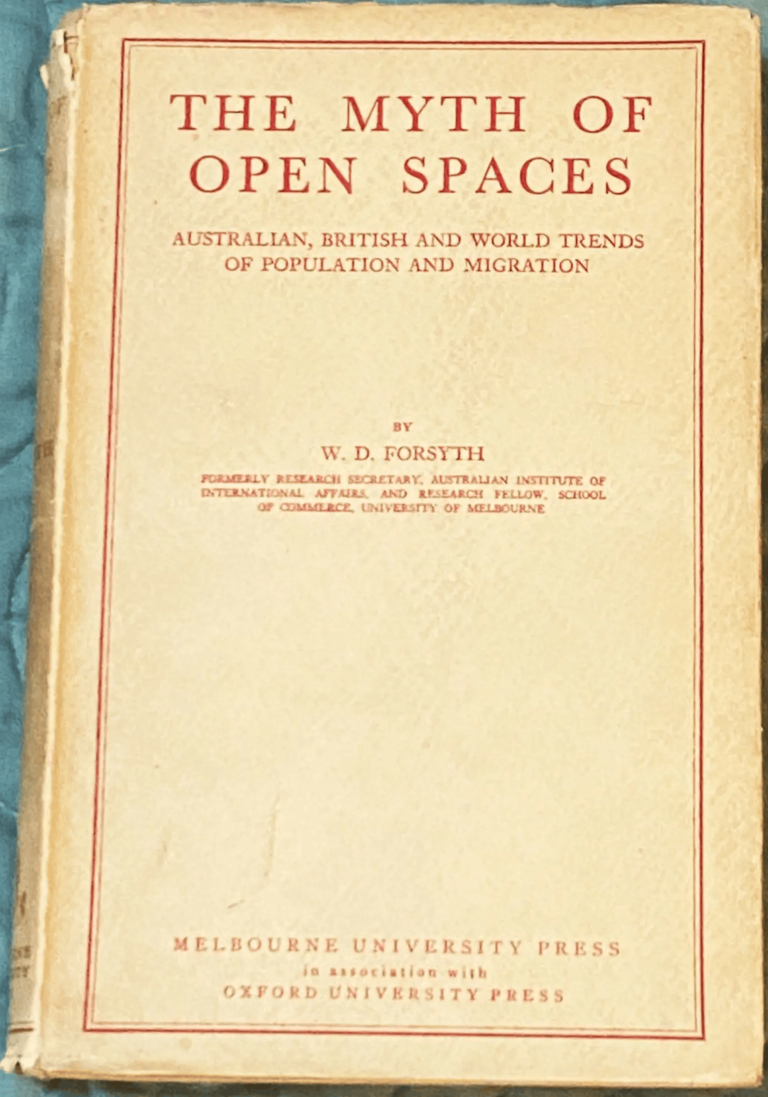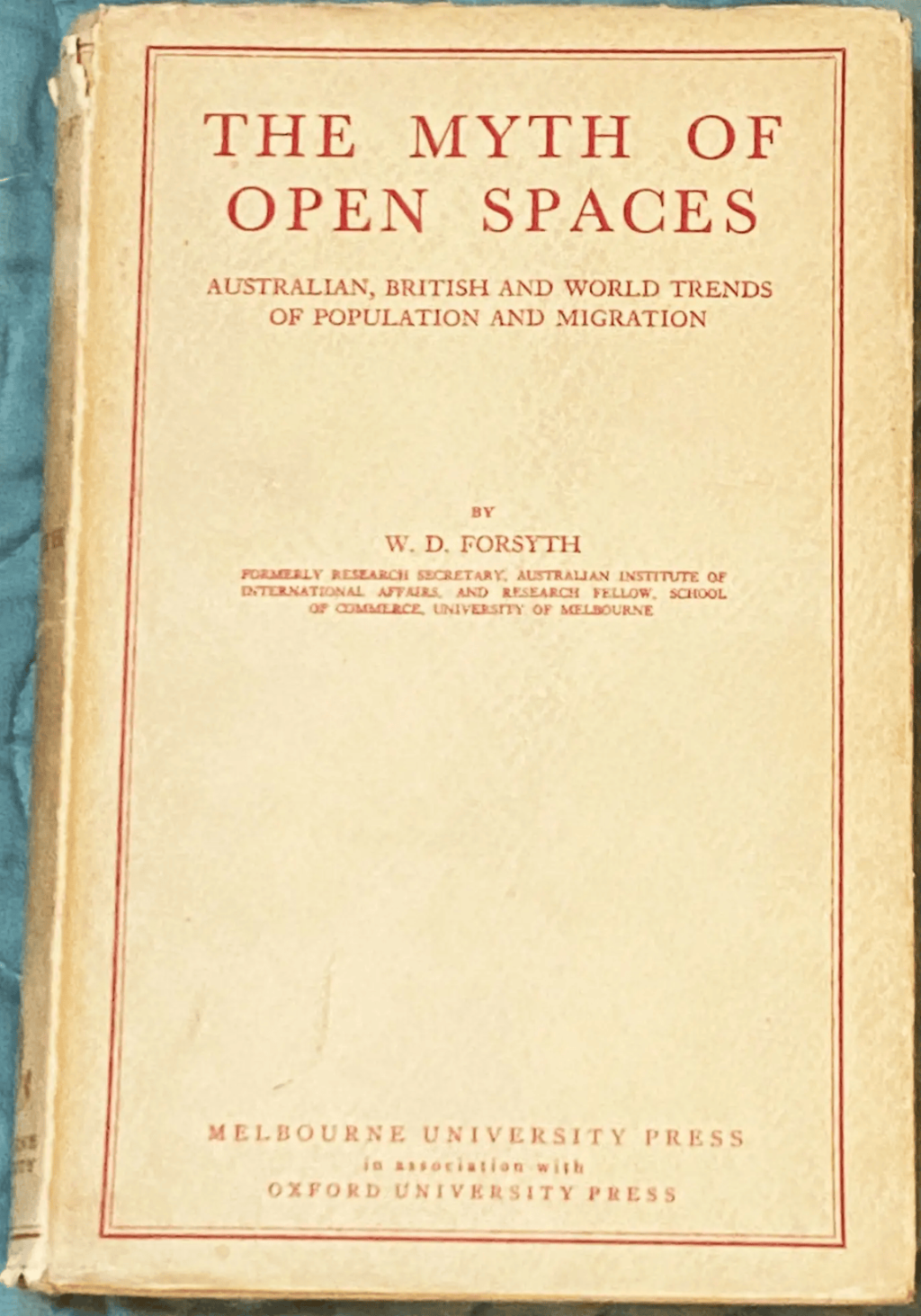W. D. Forsyth, The Myth of Open Spaces: Australian, British and World Trends of Population and Migration (1942)
William Douglass Forsyth was an Australian scholar of International Relations, who later became a diplomat. He would play an important role during the Menzies era as the leading figure within the Department of External Affairs who opposed Menzies’s approach to the Suez Crisis. However, Menzies respected his talents and bore him no grudge such that in 1959 Menzies would appoint Forsyth as Australia’s first Ambassador to South Vietnam.
At the time of authoring The Myth of Open Spaces Forsyth was working as a research officer for the Australian Institute of International Affairs & research fellow for the University of Melbourne’s commerce department, having spent much of the late 1930s researching in Britain and Europe with the backing of the Rockefeller Foundation. Armed with this expertise, the book set out to tackle the pressing post-war problem of immigration at a time when the debate over the imperative to ‘populate or perish’ was starting to gain steam. It would play a small but significant role in providing an intellectual and evidence-based justification for the eventual post-war relaxation of the White Australia policy to allow non-British migrants from continental Europe.
The book’s title came from the fact that the author rejected the idea that Australia had the capacity to support a population similar to that of the United States, and believed that the old-dream of ‘closer settlement’ in which sparsely settled land was linked to future economic potential would have to be rethought. Not only was much of the continent desolate and uninhabitable, but the trend was towards mechanisation in agriculture (requiring less people), and Australia was at risk of out-producing the demand from its potential international markets for export. Absorbing immigrants would therefore have to rely on expanding secondary and tertiary industries, as ‘technical developments… [had meant] economic opportunity has become a feature, not of open spaces, but of areas of concentrated population’. Though again Forsyth warned that this would only give Australia the capacity for a ‘moderate’ annual intake of people.
Those people would not be found in Britain, which was experiencing a significant demographic collapse, and would instead have to be found on the continent – including not just the more ‘racially desirable’ north-west (which like Britain would have few to give) but also the south-east. This was something that Joseph Lyons had already tentatively indicated, when he announced in 1938 that the Australian Government would accept 15,000 refugees in the wake of Hitler’s annexation of part of Czechoslovakia; setting out a course that Chifley and Menzies would later follow by accepting huge numbers of displaced persons from Eastern Europe.
Their number would prove to be far greater than Forsyth’s pessimistic views as to how many people Australia’s economy could successfully integrate, and it helped that markets for Australian produce also ended up expanding beyond Forsyth’s calculations. Nevertheless, The Myth of Open Spaces was significant in laying the groundwork for Australia’s landmark policy shift. This was something that Menzies himself advocated from Opposition before it became official Labor policy. In 1943 he argued:
‘The greatest guarantee, not only of the safety of Australia but of its future material prosperity, would be a population of at least twenty million. If we are to rely on natural increase, this goal cannot be achieved for a century or two – and with our present population we may not hope to last so long as an independent people. The inevitable deduction from this is that we must have a positive, active and vigorous encouragement of migration. Yet, if you turn your minds back you will recall that for fifteen years before this war there was an attitude of mild hostility on migration into Australia. Are we proposing to resume this outlook when the war is over? Are we going to be timid about the temporary effect, social and industrial, of large migration, or are we to see in it a real source of strength? It is curious that a race so mixed as our own, which derives its strength and resilience from its mixture of English, Irish, Scots, Welsh, Cornish and, going back further, the Celt, the Angle, the Saxon, the Norman, should have become recently so sensitive about the purity of its blood. Migration into Australia, particularly from Northern European counties, will in the long run bring to us nothing but vigour and advantage.’
The climate of the time meant that neither Menzies nor Forsyth was yet willing to countenance opening Australia to Asian immigration, though the latter did foreshadow the former’s great investment in the Colombo Plan by arguing that Australia ‘must aid industrial development and education in Asia’. In turn Colombo Plan students would help to break down the prejudices that underlay the restrictions on Asian migration.
It is also worth noting that Forsyth was very clear on the fact that Australia should not rely on immigration alone to increase its population, and that a high birthrate was also crucial to the health of society. This was something which the Menzies Government would achieve by making great investments in signature policies like child endowment and homeownership, fostering a ‘baby boom’ which followed Forsyth’s advice that ‘you can’t get babies at bargain prices’.
You might also like...
Sign up to our newsletter
Sign up for our monthly newsletter to hear the latest news and receive information about upcoming events.



